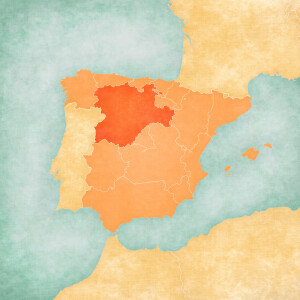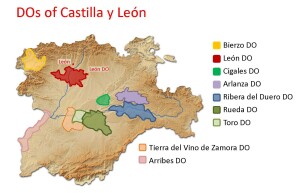 Attention, wine students! The Tierra de León DO (approved in 2007) has changed its name; the new name is: León DO.
Attention, wine students! The Tierra de León DO (approved in 2007) has changed its name; the new name is: León DO.
The León DO is located along the Esla River, just a few miles (km) south of the city of León. It is perched atop the high plateau—the Meseta Central—that covers much of central Spain and as such, its vineyards are located at an average of 2,650 feet (800 m) above sea level.
The León DO is largely red wine country; more than 90% of its vines are planted to red grapes. The leading grape variety—accounting for nearly 70% of the region’s 4,100 acres (1,660 ha) of vines—is Prieto Picudo, typically the majority variety in the areas rich-and-fruity red wines (as well as a small showing of rosé).
Prieto Picudo is thought to be native to the area just south of the city of León and is found almost exclusively in Castilla y León. The vine tends to produce small bunches of compact grapes with somewhat thin skins. The wines produced using Prieto Picudo are known for their cherry-red hue, high aromatics (including cherry, red berry, black pepper, and forest floor) as well as a good zing of acidity and alcohol.
 The remainder of the of the (red grape) vineyards are planted to Tempranillo (occupying 17% of the area), Mencía (4%) and Garnacha Tinta (less than 1%). The tinta (red wines) of León are required to be made using a minimum of 60% (combined) Preito Picudo and/or Menía—a nod to these unique grapes considered to be native to the area. The remainder of the blend (up to a maximum [combined] of 40%) may be comprised of the accessory varieties—Tempranillo and Garnacha Tinta.
The remainder of the of the (red grape) vineyards are planted to Tempranillo (occupying 17% of the area), Mencía (4%) and Garnacha Tinta (less than 1%). The tinta (red wines) of León are required to be made using a minimum of 60% (combined) Preito Picudo and/or Menía—a nod to these unique grapes considered to be native to the area. The remainder of the blend (up to a maximum [combined] of 40%) may be comprised of the accessory varieties—Tempranillo and Garnacha Tinta.
The León DO also produces a small amount of white wine; just under 10% of the area’s vineyards are planted to white grapes. Wine students will be interested to know that the regulations concerning the area’s white wines were recently updated, and that the current laws allow for just three white grapes— Verdejo, Albarín Blanco and Godello—to be so used. (Palomino and Malvasia are no longer allowed, as of the 2020 vintage).
References/for more information:
- Pliego de Condiciones for the Leon DO updated as of Novmeber 2020
- EU Commision Implementing Decision regarding Name Change of the Leon DO
- Consejo Regulador of the León DO
- Robinson, Jancis, Julia Harding, and José Vouillamoz: Wine Grapes. New York, 2012: Harper Collins Publishers
Post authored by Jane A. Nickles…your blog administrator: jnickles@societyofwineeducators.org